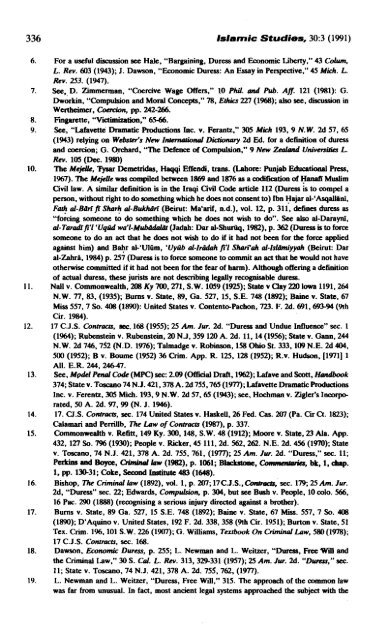LAW OF DURESS IN ISLAMIC LAW AND COMMON LAW: A ...
LAW OF DURESS IN ISLAMIC LAW AND COMMON LAW: A ...
LAW OF DURESS IN ISLAMIC LAW AND COMMON LAW: A ...
Create successful ePaper yourself
Turn your PDF publications into a flip-book with our unique Google optimized e-Paper software.
Islamic Studies, 30:3 (1991)<br />
For a useful discussion see Hale. "Bargaining, Duress and Economic Liberty." 43 Cdum.<br />
L. Rev. 603 (1943); J. Dawson, "Economic Duress: An Essay in Perspective," 45 Mich. L.<br />
Rev. 253. (1947).<br />
See, D. Zimmerman, "Coercive Wage Offers," 10 Phil. and Pub. Aff. 121 (1981): G.<br />
Dworkin, "Compulsion and Moral Concepts," 78, Ethh 227 (1968); also see, discussion in<br />
Wettheimcr. Coacion, pp. 242-266.<br />
fingarctte, "Vition." 6546.<br />
See, "Lafavette Dramatic Reductions Inc. v. Ferank." 305 Mich 193, 9 N. W. 2d 57,65<br />
(1943) relying on Webster's Ncw Intrmotional Dictionary 2d Ed. for a definition of dwess<br />
and coercion; G. Orchard. "The Defence of Compulsion." 9 New Zcoland UniwrsiricJ L.<br />
Rev. 105 (Dec. 1980)<br />
The MejeUe, Tysar Demetridas, Haqqi Effendi, trans. (Lahore: Punjab Educptid Pms.<br />
1%7). The MejeUe was compiled between 1869 and 1876 as a codification of Hanafi Muslim<br />
Civil law. A similar definition is in the Iraqi Civil Codc article 112 (Duress is to compel a<br />
person, without right to do something which he does not consent to) bn Hajar al-'Asqallani,<br />
Fat+ af-Bdrifi Sharh af-BuWlriri (Beirut: Ma'arif, n.d.), vol. 12, p. 311, defines duress as<br />
"forcing someone to do something which he does mt wish to do". See also al-Darayni,<br />
af-Tardifi'l 'Uqrid wa'l-MubddcJirr (Jadah: Dar al-Sh-, 1982). p. 362 (Duress is to force<br />
someone to do an act that he does not wish to do if it had not been for the force applied<br />
against him) and B+r al-'UJBm, 'Uytib al-lrcidoh fi'l Shaniah af-lshniyyah (Beirut: Dar<br />
al-Zahri, 1984) p. 257 (Duress is to force someone to commit an act that he would not have<br />
otherwise committed if it had not been for the fear of harm). Although offering a definition<br />
of actual duress, these jurists are not describing legally recognisabk duress.<br />
Nall v. Commonwealth, 208 Ky 700,271, S.W. 1059 (1925); State v CIay 220 Iowa 1191,264<br />
N.W. 77, 83, (1935); Burns v. State, 89, Ga. 527, 15, S.E. 748 (1892); Baine v. State, 67<br />
Miss 557.7 So. 408 (1890): United States v. Contentc+Pachon, 723. F. 2d. 691,693-W (9th<br />
Cir. 1984).<br />
17 C.J.S. Conrroc~, kc. 168 (1955); 25 Am. Jur. 2d. "Duress and Undue Influence" sec. 1<br />
(1%4); Ruhenstein v. Rubenstein, 20 N.J, 359 120 A. 2d. 11, 14 (1956); State v. Gann, 244<br />
N.W. 2d 746,752 (N.D. 1976); Talmadge v. Robinson, 158 Ohio St. 333,109 N.E. 2d 404,<br />
500 (1952); B v. Boume (1952) 36 Crim. App. R. 125, 128 (1952); R.v. Hudson, [I9711 1<br />
All. E.R. 244, 246-47,<br />
See. Mpdel P d Code (MPC) set: 2.09 (Of6cial Draft. 1962); Lafave and Scott. Handbook<br />
374; State v. Toscano 74 N.J. 421,378 A. 2d 755.765 (1977); Lafavette Dramatic Rodudions<br />
Inc. v. Ferenk, 305 Mich. 193.9 N.W. 2d 57.65 (1943); see, Hochman v. Zigler's Incorpo-<br />
rated, 50 A. 2d. 97.99 (N. J. 1%).<br />
17. C3.S. Confmcfs, sec. 174 United States v. Hasttell, 26 Fed. Cas. 207 (Pa. Cu Ct. 1823);<br />
Calamari and Perrillb, The Low of Confmcrs (1987). p. 337.<br />
Commonwealth v. Refitt, 149 Ky. 300,148, S.W. 48 (1912); Moore v. State, 23 Ala. App.<br />
432, 127 So. 796 (1930); People v. Ricker, 45 111,2d. 562,262. N.E. 2d. 456 (1970); State<br />
v. Toscano, 74 N.J. 421, 378 A. 2d. 755, 761, (1977); 25 Am. Jw. 2d. "Duress." sec. 11;<br />
Pdha d Boyce. Crimind hw (l!J82), p. 1061; BlacLstoac, Cornmcnforics, bk. 1, chap.<br />
1. pp. 1W31; M e. Second Institute 483 (1648).<br />
Bishop, The Criminaf law (1892). vol. 1, p. 207;17C.J.S.,Conbacrr, sec. 179; 25Am. Jur.<br />
2d, "Duress" sec. 22; Edwards, Compulsion, p. 334, but see Bush v. People, 10 colo. 566,<br />
16 Pac. 290 (1888) (recognising a serious injury directed against a brother).<br />
Bums v. State, 89 Ga. 527, 15 S.E. 748 (1892); Baine v. State. 67 Miss. 557, 7 So. 408<br />
(1890); D'Aquino v. United States, 192 F. 2d. 338,358 (9th Cir. 1951); Burton v. State, 51<br />
Tex. Crim. 1%. 101 S.W. 226 (1907); G. Williams. Textbook On Criminul h w, 580(1978);<br />
17 C.J.S. Contmcu, sec. 168.<br />
Damon, Economic Duress, p. 255; L. Newman and L. Weitzer, ''Dwess. Free Will and<br />
the Criminal Law." 30 S. Cd. L. Rev. 313,329-331 (1957); 25 Am. Jw. 2d. "Dunu." sec.<br />
11; State v. Toscano, 74 N.J. 421, 378 A. 2d. 755, 762, (1977).<br />
L. Newman and L. Weitzer. "Duress, Free Will," 315. 'Ibe approach of the common law<br />
was far from unusual. In fact, most anaent legal systems approached the subject with the
















